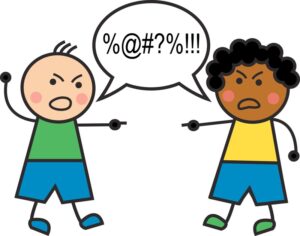What’s Wrong With Critical Race Theory, Continued
 Introduction
Introduction
This post is a continuation of the analysis begun in the preceding post (“What’s Wrong With Critical Race Theory?”).
That post showed that Critical Race Theory (“CRT”) is based on the unsupported opinions of individuals who view the entire, complex world through the narrow lens of racial conflict. It also rebutted the assumption that racism is the sole cause of all inequalities between blacks and whites in today’s society.
Additional flaws in Critical Race Theory include the following:
 Race Neutrality Is Not “Racism”
Race Neutrality Is Not “Racism”
Ibram X. Kendi and other CRT advocates have coined a new definition of “racism” that would make the great majority of people racists, even if they are not. They say that being color-blind in the treatment of others — treating all people the same regardless of their race — is racism! To them, it is not enough to be race-neutral. They say that color blindness is racism because it tends to sustain the status quo in which there are unequal outcomes. Therefore, to avoid the “racist” label, you must be “anti-racist.”
What is an anti-racist? It is a person who actively pushes for equal outcomes, not just equality of opportunity. You are a racist if you don’t support an anti-racist’s affirmative-action policy proposals for eliminating racial disparities. There is no middle ground. You are either a racist or an activist anti-racist.
Kendi regards all differences in economic outcomes as inequitable. As an example, he cites the disparity between blacks and whites in home ownership (71% for whites vs. 41% for blacks in 2014). In his opinion, it is racist to tolerate this. So, to avoid being a racist, you must support activist policies to eliminate the gap (perhaps government guarantees on loans to black borrowers?).
There can be many good, non-racist reasons for opposing a proposal to create equal outcomes. For example, a proposal might be economically infeasible, or it might lead to improper dependency on the government, or it might undercut the free-market economy, or it might lead to undesirable racial conflict. But if you or I say such things, we will be accused of “racism.”
In the field of education, standardized tests can produce unequal outcomes. A test of mathematical attainment might show that Asian Americans, as a group, score better than whites, and that whites score higher than blacks. In the world of CRT, the different outcomes prove that the tests are racist. What other explanation could there be? Thus, the tests must be scrapped altogether or altered in a way that produces similar results for each racial group.
Unfortunately, the Fairfax County School Board has bought into this way of thinking. For example, the entrance criteria for the elite Thomas Jefferson High School for Science and Technology were changed last year to eliminate reliance on an entrance exam in favor of geographic and socioeconomic criteria that would reduce the percentage of Asian Americans in the school (formerly about 70%) and increase the percentage of other minorities. Other internal documents also suggest that the school authorities equate unequal results with unfairness.
 CRT’s Opposition to Integration and Assimilation Is Misguided
CRT’s Opposition to Integration and Assimilation Is Misguided
The motto of the United States, stamped on our coins, is “E Pluribus Unum,” translated “From Many, One.” It refers to the melting pot of American culture. People from the four corners of the world have settled here because they admired our way of life. They brought their diverse cultures with them, and those cultures have affected the ever-evolving American culture, but the new arrivals have generally wanted to assimilate into American society.
African Americans were long denied the right to integrate. Slavery, followed by Jim Crow laws and de facto segregation, kept them apart. But civil rights leaders and other well-intentioned people advocated for breaking down the barriers, and there has been much progress over time.
CRT proponents, however, oppose integration and assimilation of blacks into a common American culture. Kendi argues, for example, that assimilation would suggest that a separate black culture is inferior. Thus, to him, an E Pluribus Unum philosophy is racist.
I have not been able to discover what it is about the predominant American culture the CRTers find objectionable or how they think “black” culture is significantly different. Kendi does say that he opposes capitalism because it fosters inequality, and he argues for the preservation of a separate dialect called Ebonics, but neither he nor other CRT proponents whom I’ve studied provide the reader with an intellectually satisfying explanation of their overall position on this issue.
Every culture needs a basic set of norms for stability. Ours include freedom of speech and religion, democracy, acceptance of diversity, universal education, a common language, individual responsibility, merit-based evaluation of performance, respect for the law and our constitutional system, free enterprise, and others. Subcultures exist and are welcome so long as they are synergistic with the basic parameters of our prevailing culture. Every group has brought its own music, art, food, religious practices, etc. to America, and those have affected the ever-evolving culture of America. African Americans have affected, and will continue to affect, our melting pot culture just as other racial and ethnic groups have done.
Immigrants from Latin America, the Middle East, India, China, Japan, Korea and elsewhere want to, and have, integrated into our culture. The majority of Americans with African roots are no different. I cannot understand why CRT advocates believe that the goal of integration should be rejected by black America.
 CRT Offers No Solutions And Is Bad Policy
CRT Offers No Solutions And Is Bad Policy
A CRT pioneer, Derrick Bell, in his book Faces at the Bottom of the Well: The Permanence of Racism (1992), concluded that racism is so deeply embedded in American society that there is no cure for it. Other believers in CRT have similar, pessimistic views of race relations. Ibram X. Kendi, in How to Be an Antiracist (2019), argues that racism is an integral part of American culture and of white subconsciousness. Robin Diangelo has no answers either; indeed, she states, in the introduction to her best-selling White Fragility (2018), that she won’t even attempt to provide a solution to to the problem of racism in America. Ta-Nehisi Coates, in Between the World and Me (2015), is also negative in his outlook: His book is little more than a diatribe against white “majoritarian pigs.”
Kendi does suggest that equality could be achieved if we could agree on an “anti-racist” agenda, by which he means massive government intervention to eliminate inequalities in home ownership, jobs and income. But he admits that this can’t be achieved without eliminating capitalism, which, by its nature, rewards some people more than others. Thus, his “solution” is unrealistic and contrary to core American values. A government-mandated system of forced equality in income and wealth would generate massive backlash by people of all races who believe in free enterprise, meritocracy and individual responsibility.
One of the most pernicious aspects of CRT is that it ignores the importance of individual responsibility. In the world of CRT, blacks are powerless victims, and the sole responsibility for eliminating inequality rests on the shoulders of the white majority. Thus, advocates like Ibram X. Kendi are critical of the many civil rights leaders, such as Martin Luther King, Bill Clinton and Barack Obama, who have called upon blacks to overcome racial disparities through education, hard work, two-parent households, avoidance of drugs, etc.
CRT philosophy is particularly pernicious when it comes to our children’s education. The world of CRT views everything in terms of race and racial conflict. To them, race is the primary factor that determines success or failure in today’s America.
Our kids should not be indoctrinated with this race-oriented approach to the world. They should be taught to be color-blind, not the opposite, and they should not be taught to chop up the population into other “identity” groupings either (e.g., sex, sexual orientation). They should not be taught that they are either “privileged” or disadvantaged by their race. There is no cause for, or benefit from, instilling guilt in white children because of their race, nor can good come from suggesting to minority children that they have a skin-color-based excuse for not performing well.
Today’s world offers almost unlimited opportunities for people of all colors to thrive. This is what our youth should be taught. If a child receives a good education, acquires job skills and is law-abiding, he or she can succeed in any field … cutting-edge science, medicine, law, politics, trades, etc. Employers throughout the country will hire qualified minorities in a heartbeat. This is the antithesis of doctrine that tells our children that the deck is stacked against them.
Teaching our students that they are “privileged” if they are white and/or that they are victims if they are in a minority group cannot heal the nation; it can only divide us. It can only foster a victimhood mentality that will prevent our next generations from becoming all they can be.
There is no doubt that slavery and a history of racism has had lasting effects. There is good reason to study the past and contemplate pathways to a better future. But the race-conflict focus of Critical Race Theory (i) willfully ignores the nature and scope of the underlying problems in the real world, (ii) fails to identify a realistic plan for the future, and (iii) would have negative, counterproductive effects.
Upcoming posts on this site will provide additional documentation of how CRT philosophy has become embedded in many insidious ways in the Fairfax County School System.
If you find this post to be useful, please share it with others.


All your points are good ones, but your most salient argument is that CRT is factually incorrect. We should be teaching our kids the truth, and don’t do them, or our country, or blacks for that matter, any favors by teaching untruths.
There have obviously been problems in our country, and there have been some problems in the way our history books have been written in the past, but we don’t fix it by teaching lies.
This is what politicians mean when they talk about “fundamentally changing our country”. Thanks for spelling it out so clearly.